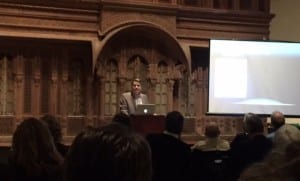My favorite part of the entire Crow Collection is always walking beneath the canopy o f origami cranes. It evokes a calming feeling of almost transcending into another world. While origami obviously doesn’t have that much
f origami cranes. It evokes a calming feeling of almost transcending into another world. While origami obviously doesn’t have that much
significance to India and Hinduism, the journey into Asian culture begins with this passage. The placement of the lecture right in front of the Upper Floors of the Façade of a Haveli from the Mughal period fully transported the event to Northern India and set the perfect tone for the subject matter.
Professor Lindquist lecture was mostly interesting because of some of the questions that it raised. Like how did Hinduism affect art in India before it became an established religion? How did the local mythology play into the development of Hinduism in art? How do you even qualify when this period officially began? So much of Indian art is intertwined with Hindu themes and figures that they’ve almost become two inseparable concepts. The large presence of art in temples only serves to further connect the two. The early presence of figures sitting in folded-leg positions on small seals carried around by the people of the Indus River Valley Civilization were the first prominent presence of Hindu mythology in Indian art. Art then gave way to the written word during the time of the Vedas as people became more nomadic.
It wasn’t until people began to settle and create a more urban society that traditional artwork began to appear again. It was in this period of Indian civilization flourishing that elaborate images and displays in temple s began to define the presence of Hinduism in Indian art. More detailed, vivid portrayals of gods and goddesses were being used alongside the inclusion of newer deities that came to prominence later in the history of Hinduism. Unfortunately, Dr. Lindquist had to end his lecture early, but listening to the history of one of civilization’s oldest religious institutions regarding the development of art was absolutely fascinating.
s began to define the presence of Hinduism in Indian art. More detailed, vivid portrayals of gods and goddesses were being used alongside the inclusion of newer deities that came to prominence later in the history of Hinduism. Unfortunately, Dr. Lindquist had to end his lecture early, but listening to the history of one of civilization’s oldest religious institutions regarding the development of art was absolutely fascinating.

